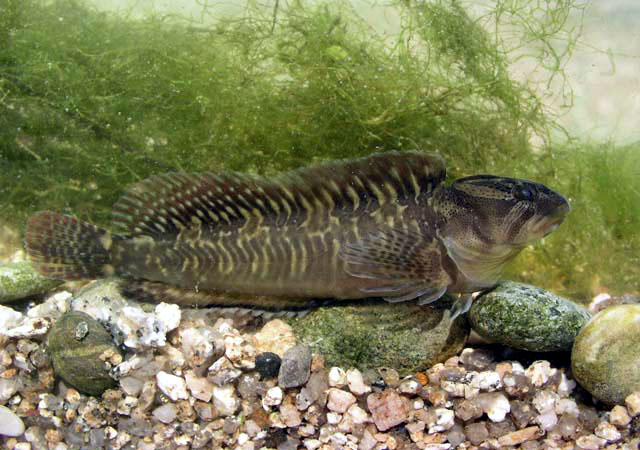| Blenniidae (Combtooth blennies), subfamily: Blenniinae |
| 15.4 cm TL (male/unsexed); max. reported age: 5 years |
|
demersal; freshwater; brackish; pH range: 6.5 - 7.5; dH range: 8 - 12 |
| Europe and Africa: Africa: Rivers and brooks in Algeria and Morocco flowing to the Mediterranean; including Israel. Europe: Albania, Croatia, France, Greece, Italy, Montenegro and Spain (Ref. 26100); Portugal (Ref. 13612). Asia: Turkey. |
|
Dorsal spines (total): 12-13; Dorsal soft rays (total): 16-17; Anal spines: 2-2; Anal soft rays: 16-19; Vertebrae: 36-36. Diagnosis: This species is distinguished from its congeners in European inland waters by the following combination of characters: a broad diagonal band of tiny dots running from eye backward and downward; branched cirrus above eye; head length 25-31% SL; upper jaw with 16-24 teeth, lower jaw with 16-20; A II,16-19; D XII-XIII,16-17 (Ref. 59043). Description: Dorsal fin with 12-13 spines and 16-17 soft rays; anal fin with 2 spines and 16-19 soft rays; pectoral fin with 12-14 soft rays; pelvic fin with 1 spines and 3 soft rays (Ref. 128181). |
| Adults occur in rivers and brooks (Ref. 4342), in relatively shallow water as well as in low altitude lakes (Ref. 30578), on stone bottom; in streams, deepest and fastest microhabitats are preferred and sometimes coastal lagoons with low salinity (Ref. 59043). Reported from marine environment (Ref. 58342). A territorial species that lives up to 5 years (Ref. 59043). Adults feed on small benthic organisms, aquatic insects and pupae (Ref. 94105). Oviparous (Ref. 205). Females spawn for the first time at the end of the first year and spawning lasts up to 3 years but with most females dying at the end of the first spawning year. One female spawns up to 1,200 eggs (usually 200-300) in a single layer under a large stone; spawns several egg portions during the season. On the other hand, the males clean, fan and defend the eggs until hatching. Several females may spawn with one male, which may guard the eggs at different stages of development (Ref. 59043). Eggs are demersal and adhesive; eggs hatch in about a week (Ref. 205, 59043). Planktonic larvae until about 1.5 cm, are drifted to and remain in quiet pools or side arms of rivers (Ref. 59043). Populations are threatened due to pollution and water abstraction (Ref. 26100); most riverine populations affected by habitat alteration (especially siltation and alteration of stream morphology), and predation of exotic species. Presence of habitat suitable for the pelagic 'larval' stage downstream of spawning sites is a limiting factor; lacustrine population are apparently safer (Ref. 59043). |
|
Least Concern (LC); Date assessed: 31 January 2006 Ref. (130435)
|
| harmless |
|
Known from Kalamas, Acheron, Alcheloos and Aliakmon drainages, Crete, most drainages of Peloponnese, lakes Doiran, Koronia, Volvi and Vistonis (Ref. 59043). Also Ref. 26100. 113969 |
Source and more info: www.fishbase.org. For personal, classroom, and other internal use only. Not for publication.

